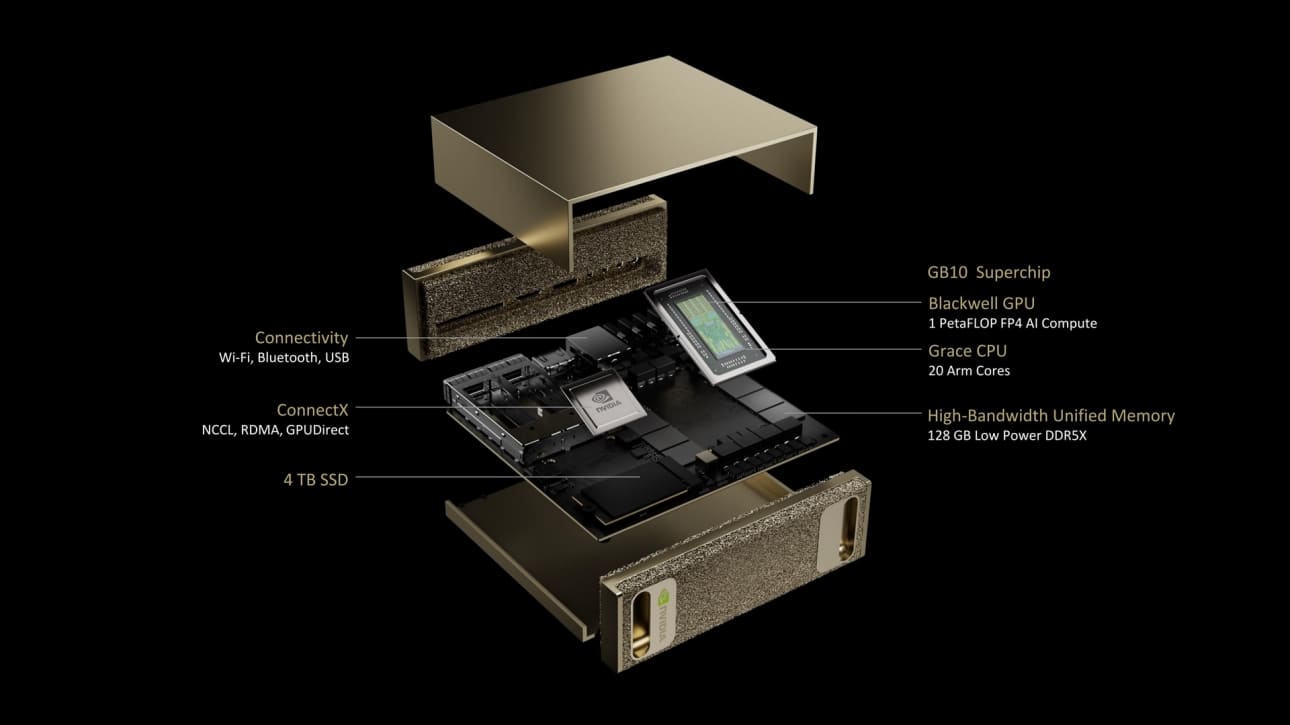The Hot Chips 2025 conference provided the stage for NVIDIA to unveil one of its most anticipated developments: the GB10 Superchip, a hybrid processor that combines CPU and GPU in a single package. Designed using 3-nanometer technology, it aims to transform the experience of AI PCs. This chip not only marks a step forward in NVIDIA’s evolution toward more compact and efficient systems but also enacts its strategy of bringing the power of AI supercomputers to desktops and workstations.
The GB10 Superchip consists of two interconnected dielets via advanced 2.5D packaging. The S-Dielet includes 20 ARM v9.2 cores arranged in two clusters of 10, with dedicated L2 cache and 32 MB shared L3 cache. The G-Dielet hosts a Blackwell-based GPU with fifth-generation Tensor cores, support for DLSS 4, ray tracing with RTX, and performance up to 1,000 TOPS in FP4 precision.
Practically, a single station equipped with the GB10 can run models with up to 200 billion parameters for inference or fine-tune models up to 70 billion—a scale previously accessible only in specialized data centers.
The first system to feature this chip is the DGX Spark, described by NVIDIA as a “mini AI supercomputer for the desktop.” Its goal is to offer a DGX-like experience in a smaller, energy-efficient format at a more accessible price point suitable for research labs, startups, and individual developers.
Key specifications include 128 GB of unified LPDDR5x-9400 memory with up to 301 GB/s bandwidth, NVMe M.2 storage options from 1 to 4 TB with automatic encryption, advanced connectivity including 10 GbE Ethernet, Wi-Fi 7, and Bluetooth 5.3. It supports multiple displays, up to 8K at 120Hz via HDMI 2.1a or 4K at 120Hz via DisplayPort, and runs DGX Base OS, which incorporates NVIDIA’s AI software stack (CUDA, TensorRT, RAPIDS, generative AI frameworks, and optimized libraries). Remarkably, the entire unit weighs only 1.2 kg and consumes around 140 W TDP, impressive given its processing power.
One of the major innovations of the GB10 is its unified memory architecture (UMA), where both CPU and GPU share the same coherent memory space, removing intermediate copies and significantly speeding up training and inference. Additionally, NVLINK C2C interconnects multiple DGX Spark units using ConnectX-7 cards, enabling models with up to 405 billion parameters in distributed configurations. This positions the GB10 as a middle ground between high-end consumer PCs and large-scale DGX servers.
NVIDIA revealed that the GB10’s development was a close collaboration with MediaTek, which provided the CPU’s intellectual property. This partnership facilitated more efficient integration of memory management and GPU traffic, critical for achieving high performance with low power consumption.
While the DGX Spark is the flagship currently, the future looks promising for a series of consumer-oriented SoCs called N1 and N1X, which will inherit much of the GB10’s innovations. These will likely bring advanced AI capabilities to portable devices and mini PCs, making powerful AI hardware accessible to a wider audience. This democratization aligns with broader trends toward local AI processing, driven by concerns over data privacy and technological sovereignty, opening new possibilities in fields like healthcare, robotics, scientific research, and entertainment.
For developers and companies, the GB10 Superchip and DGX Spark provide a versatile development platform for prototyping generative and reasoning models, fine-tuning pre-trained models for specific tasks, conducting large-scale inference locally, and building edge applications such as robotics, smart cities, and computer vision with frameworks like Isaac or Metropolis. NVIDIA reinforces its ecosystem approach by offering integrated hardware, optimized software, and compatibility with their cloud and data center infrastructure.
With the announcement of the GB10, NVIDIA enters the AI PC market, competing directly with Intel and AMD, who also have processors with integrated AI acceleration capabilities. NVIDIA’s leadership in software ecosystems and the proven high performance of its Blackwell GPU in data centers could give it an edge in translating this power into consumer products. If successful and competitively priced, NVIDIA could establish a new category of personal computers where AI becomes central rather than supplementary.
Ultimately, the NVIDIA GB10 Superchip represents more than a new processor; it symbolizes the blurring lines between supercomputing and personal computing. NVIDIA’s vision is for developers, data scientists, and startups to access power previously reserved for large-scale server racks directly from their desks. The emergence of the DGX Spark and future consumer variants confirms that AI’s future will be both cloud-based and local, energy-efficient, and versatile.

